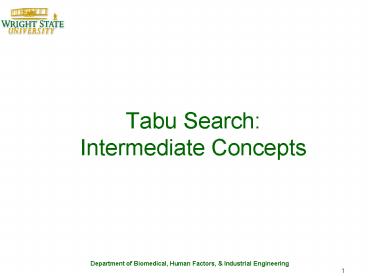Tabu Search: Intermediate Concepts - PowerPoint PPT Presentation
1 / 18
Title:
Tabu Search: Intermediate Concepts
Description:
Department of Biomedical, Human Factors, & Industrial Engineering. 1. Tabu Search: ... of Biomedical, Human Factors, & Industrial Engineering. 4. What if Short ... – PowerPoint PPT presentation
Number of Views:184
Avg rating:3.0/5.0
Title: Tabu Search: Intermediate Concepts
1
Tabu Search Intermediate Concepts
2
Short Term Memory Issues
- List size
- No agreement on a best size
- Generally want smaller sizes for stringent
restrictions - Sizes can vary by specific list
- Tabu restrictions
- Context dependent
- Can have multiple types of restrictions
- Not all necessarily are in effect simultaneously
3
Short Term Memory Issues
- Aspiration criteria
- Can have multiple criteria
- Each criteria may have its own tenure
- Again, not all need be in effect at any one time
- Just about anything goes as an aspiration
criteria - Litmus test is does the aspiration criteria work
4
What if Short Term Fails?
- Short term memory functions and tabu search often
sufficient for many problems - There are cases where the approach requires more
power - Maybe the best so far curve has leveled off
- Maybe we know better solutions are available
- The other memory components of tabu search can
now come into play - Approached failed to drive search into new areas
5
Bridging Data Structure
- Name provided to distinguish how data structures
are used and exploited - These allow movement between memory functions
- Based on auxiliary data captured by search
- Analyzed on-line and events triggered
- Go to intermediate memory functions
- Go to long-term memory functions
- Change tenure, restrictions, aspiration criteria,
etc.
6
Tabu Search Functions
Current Focus
7
Purpose of Functions
8
Intermediate Tabu Search
- Primarily a return to good areas
- Elite List of solutions
- Return to elite solutions and intensify
- Good areas include
- Strong solutions visited
- Strong solutions evaluated but not visited
- Solutions constructed via some set of rules
- Resume or restart search from a new area when
search in an old area bogs down
9
Intermediate Tabu Search
Apply Short-Term Tabu Search
When Improvement Stops, Get Member of Elite List
Continue with the Short-Term Tabu Search from
new Solution
Continue until Stopping Criteria is Met
Ref OR/MS Encyclopedia
10
Elite Set Approaches
- Voss (1993) erases memory and returns to previous
solutions different from current solution - Glover (1990) tracks quality neighbors not picked
- An unvisited neighbor strategy
- Tsubakitani and Evans (1998) jump to new random
solutions - Kinney et al. (2003) generate list of good
solutions
11
Tabu Search Functions
Current Focus
12
Purpose of Functions
13
Long-Term Tabu Search
- Short and Intermediate functions may not provide
enough diversification - Want really new solutions move to new portions
of the search space - Long-term memory functions
- Counts of move characteristics
- Move distance evaluations
- Relax constraints-- Strategic Oscillation
- Randomization of solutions
14
Long-Term Tabu Search
Apply Short-Term Tabu Search
When Some Trigger Occurs, Initiate Long-Term
Functions
Continue Short-Term Tabu Search from new Solution
Continue until Stopping Criteria is Met
Ref OR/MS Encyclopedia
15
Diversification
- Strategic oscillation
- Systematically cross boundaries ordinarily fixed
- Allow movement to regions previously not reached
- Vocabulary building
- Generate new solutions based on knowledge of
solutions visited - Exploit data structures (memory) containing
search information - e.g., examine frequency counts and fix variables
to values
16
Diversification
- Move distance
- Force moves within the search that cause a large
change is the structure of the solution - Essentially a new evaluation function focused on
change versus quality of solution neighborhood - Also called move influence
- Path relinking
- Choose two (good) solutions
- Generate a path between the solutions
- Tunnel through infeasible region if necessary
17
Some Key Concepts
- Candidate Move and Candidate List
- Tabu Tenure and Tabu List
- Aspiration Criteria
- Do not ignore good solutions, make exceptions
- Aggressive Exploration
- Explicit Memory
- Keep track of lots of information
- Intensification and Diversification
- Move between the two and search the space
18
Questions?































